From the incorporation of eco-friendly materials and minimalist designs to the resurgence of vintage aesthetics and the integration of multifunctional elements, fireplace designs are becoming more personalized and integral to interior design. A custom fireplace not only enhances the visual appeal of indoor and outdoor living spaces but also caters to practical considerations of energy efficiency and space utilization. In this post on the Journal, we take a look at the latest trends in fireplace mantelpieces, surrounds, and hearths. We also weigh the pros and cons of electric, gas, and traditional wood fireplaces so you can select the best option for your home. To spark inspiration, we have pulled photos of the most stunning fireplaces from the LUDC archives. For our favorite fireplace trends of 2024 and a comprehensive guide to selecting the right design for your space, read on!
Answering Your FAQs About Fireplace Design
What is the Anatomy of a Traditional Fireplace?
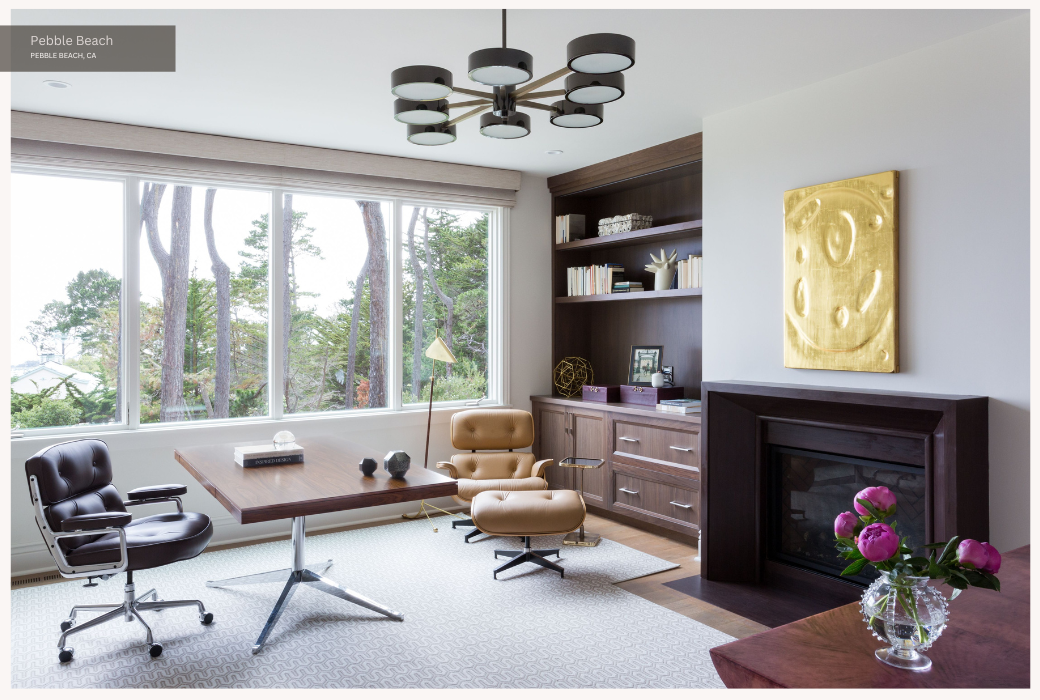
A traditional fireplace consists of several key components, each serving a specific function in its operation, safety, and aesthetics. Understanding these parts is important for maintenance, efficient use, and troubleshooting. Knowing the names of each component can also help you communicate with a designer or carpenter when creating your perfect bedroom or living room fireplace.
Firebox
The firebox is the main section where the fire burns. It’s typically constructed of fireproof materials like brick, stone, or metal. The firebox contains the fire and withstands the intense heat generated during burning.
Hearth
The hearth is the floor section of the fireplace, extending into the living space. It’s made of non-combustible materials like brick, stone, or tile and provides a safe area in front of the firebox that can withstand sparks or embers that may escape.
Mantel
The mantel is the decorative framework around the fireplace. It can be simple or elaborate, and it often serves as a shelf for displaying decorative items. The mantel can be made from various materials, including wood, stone, or marble.
Damper
Located just above the firebox in the chimney, the damper is a plate that moves to regulate the draft and airflow in your fireplace. It can be opened to allow smoke to exit through the chimney when a fire is burning and closed when the fireplace is not in use to prevent heat loss.
Flue
The flue is the passageway within the chimney through which smoke and gases travel upward and out of the building. The flue must be properly sized and maintained to ensure efficient and safe fireplace operation.
Chimney and Chimney Cap
The chimney is the structure that encloses one or more flues. It extends above the roofline and provides the necessary draft to ensure proper combustion and the evacuation of smoke and gases. Situated at the top of the chimney, the chimney cap prevents rain, birds, and debris from entering the flue. It usually includes a mesh screen to keep animals out while allowing smoke to escape.
Ash Dump Door
In some fireplaces, an ash dump door is located at the bottom of the firebox. This door leads to an ash pit where ashes can be swept for easy cleanup.
Fireplace Doors or Screen
Fireplace doors or screens are located at the front of the firebox. They serve to contain sparks and embers but can also boost your fireplace’s efficiency by reducing the amount of indoor air lost up the chimney.
Lining
The interior walls of the firebox are often lined with firebricks or a refractory panel to provide additional insulation and heat reflection, enhancing the safety and efficiency of the fireplace.
Who Crafts Custom Fireplace Designs?
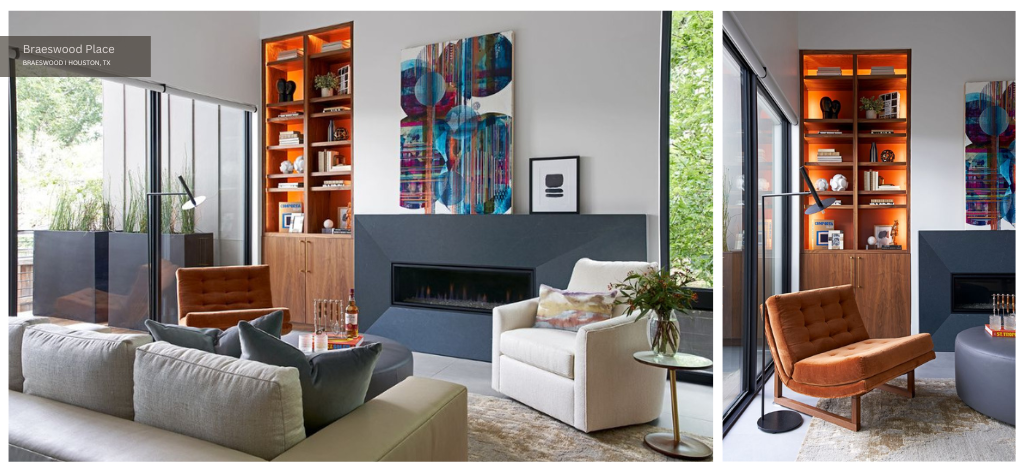
As Yelena Moroz Alpert and Madeleine Luckel write in this article for Architectural Digest, “Nothing feels more inviting and enviable than a stylish and statement-making hearth in your living room—or in any other space in the house, for that matter.” Given this, it’s essential that you choose the right design team to craft your custom fireplace. When working on your fireplace design, an interior designer will focus on the aesthetics of your mantel, hearth, firebox, surround, and any doors or screens you wish to include. They will do the same for indoor and outdoor fireplaces.
The structural elements of fireplaces and chimneys are typically designed by professionals with expertise in building design and structural engineering, such as architects, structural engineers, fireplace design specialists, masonry contractors, and HVAC engineers. As such, your interior design team might consult with the aforementioned specialists when creating your custom fireplace.
What’s the Difference Between a Mantlepiece and a Fireplace Surround?
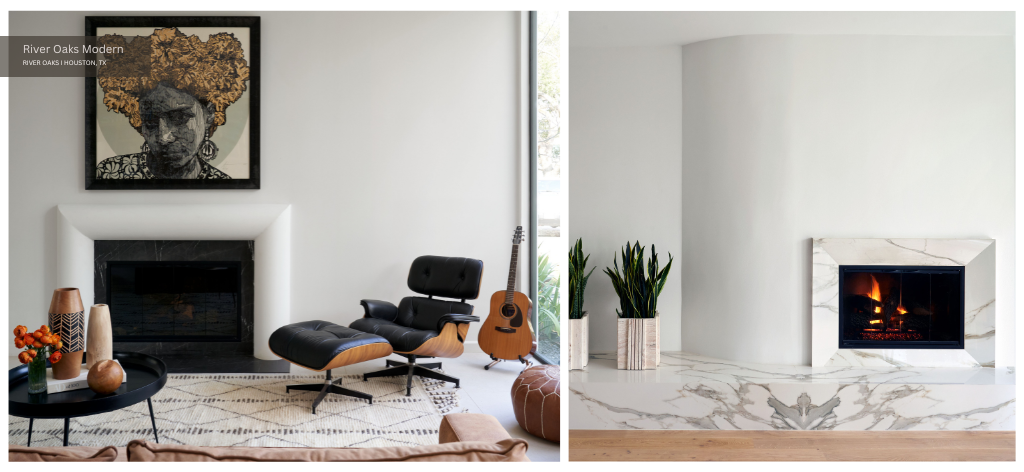
The mantelpiece is the decorative shelf or structure above the fireplace. In traditional designs, it often extends across the top of the fireplace and may continue down the sides, forming part of the framework. The mantelpiece serves both a functional and aesthetic purpose.
Functionally, it can provide a shelf for displaying items like photographs, artwork, or decorative objects. Aesthetically, it can be a significant design element in a room, often reflecting the style of the home. Mantelpieces can be made from various materials, including wood, stone, or marble, and can range from simple, clean designs to elaborate, ornate structures.

The fireplace surround refers to the structure that encloses the fireplace on three sides – the two sides and the top (excluding the mantelpiece). It typically includes the side pillars and the area directly above the fireplace opening up to the mantel.
The surround plays a key role in the overall appearance of the fireplace and can be made from a wide variety of materials including ceramic tile, brick, stone, or wood. The design of the surround can vary widely, from minimalist and modern to intricate and traditional, depending on the desired aesthetic.
While both the mantelpiece and fireplace surround are integral to the design and functionality of a fireplace, the mantelpiece primarily refers to the shelf above the fireplace, and the surround encompasses the immediate structure surrounding the fireplace opening. Both elements contribute significantly to the style and character of the fireplace as a whole.
How Do Traditional Wood-Burning Fireplaces Compare to Gas and Electric Fireplaces?
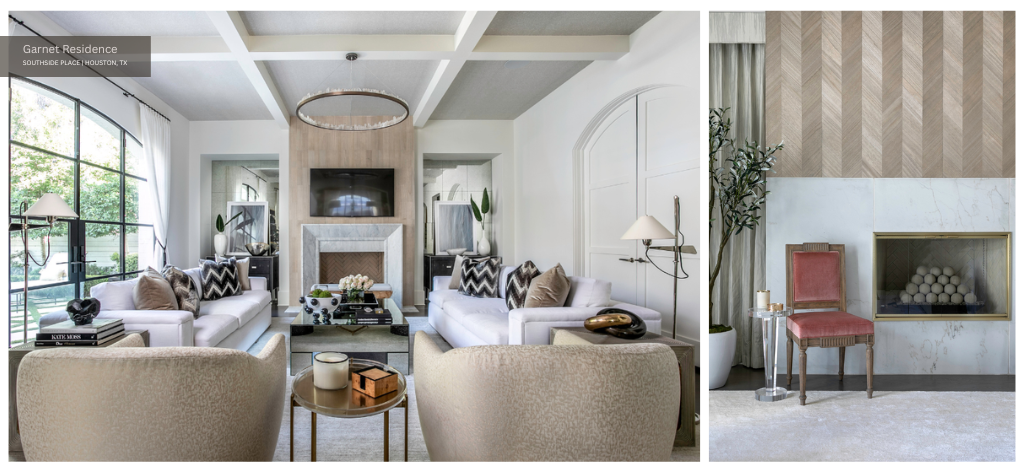
Today’s homeowner can choose between many different fireplace options, each offering distinct benefits and experiences. The three primary types are gas, electric, and traditional wood-burning fireplaces.
Gas fireplaces provide efficient heating and ease of use, electric fireplaces offer simplicity and safety, and traditional wood-burning fireplaces deliver an authentic and aesthetic experience. The choice among these depends on individual preferences for convenience, environmental impact, installation requirements, and the desired ambiance. Let’s take a closer look at their advantages and disadvantages.
Gas Fireplaces
Gas fireplaces are efficient and easy to use. A gas fireplace offers quick heating solutions and consistent temperature control, making it a convenient choice for many homeowners. Additionally, they burn cleaner than wood, producing fewer emissions and requiring less cleanup.
However, they come with higher installation costs, primarily due to the need for a gas line and proper venting systems. Aesthetically, while modern designs are improving, some may find that gas fireplaces lack the traditional charm and ambiance of a wood-burning fireplace. Still, the dancing flames in gas fireplaces are fairly realistic compared to those of a wood-burning fireplace.
Electric Fireplaces
Electric fireplaces have gained popularity due to their ease of installation and low maintenance. They are often plug-and-play units that do not require venting, making them a versatile option for various settings. Safety and environmental friendliness are significant advantages of installing an electric fireplace, as it produces no emissions.
However, they may offer a less authentic experience, lacking the sound and feel of the roaring fire you might enjoy in a traditional wood-burning fireplace. While convenient, they might not be as effective in heating larger spaces as their gas or wood counterparts.
Traditional Wood-Burning Fireplaces
Traditional wood-burning fireplaces provide a classic and authentic experience, favored for their aesthetic appeal and the unique type of warmth they produce. The crackling sound of burning wood and the smell associated with a wood fire are unmatched experiences.
Despite their appeal, they require more maintenance, including regular cleaning of ashes and chimney sweeping to prevent fire hazards. Additionally, environmental concerns due to higher emissions and particulate release are significant considerations for those conscious about their ecological footprint.
What About No-Burn Laws and Emissions Restrictions?
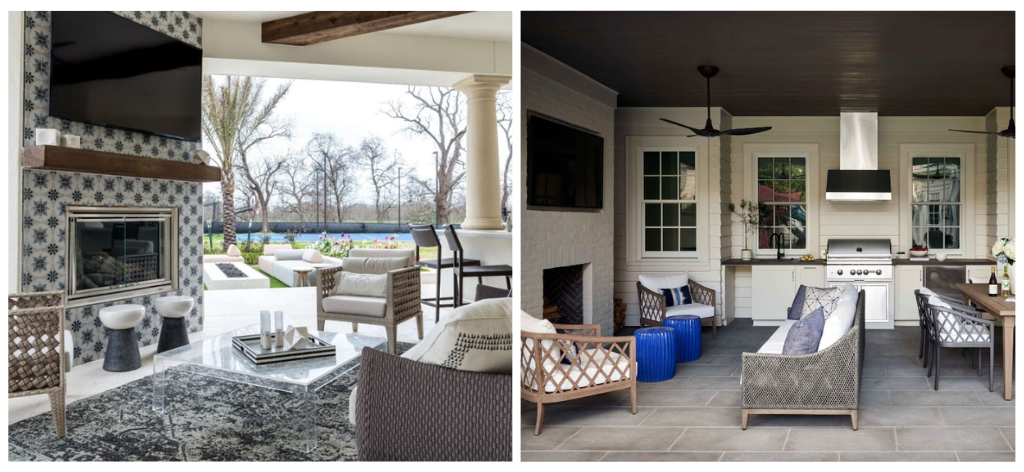
Some cities and states have implemented bans or heavy regulations on wood-burning fireplaces and stoves, primarily due to environmental and health concerns. For example, in California, particularly the Bay Area, all wood-burning appliances have been banned in newly constructed homes since 2015.
This ban is part of efforts to control air pollution and improve air quality. Similarly, Marin County in California and Tacoma-Pierce County in Washington have strict measures prohibiting fireplaces or wood stoves that aren’t EPA-certified, meaning they must meet certain emissions standards.
In other areas like Puget Sound, Washington, while wood burning is allowed, there are strict ordinances regarding the opacity of smoke from chimneys and specific times when burning is permitted or prohibited. Some towns also have dynamic rules regarding wood-burning appliances, including emission requirements and restrictions on when firewood can be burned.
In addition to local bans, many communities and states encourage or mandate the removal of non-certified wood stoves before selling a home. This is the case in Oregon, Marin County, and Fairbanks, where non-certified wood stoves must be removed before a property sale.
As for gas fireplaces, there is a growing movement towards phasing out gas appliances in favor of greener alternatives. For instance, over 50 cities in California have banned the inclusion of new gas appliances in new constructions starting from 2019. However, existing installations are typically grandfathered in when new legislation is passed.
These regulations and trends reflect increasing awareness and concern about the environmental and health impacts of traditional heating methods, and the need for more sustainable, cleaner alternatives. For specific rules and regulations in a particular area, it’s recommended to consult local ordinances, contact local health departments, or explicitly ask your interior design team.
These Are the Latest Fireplace Trends in 2024
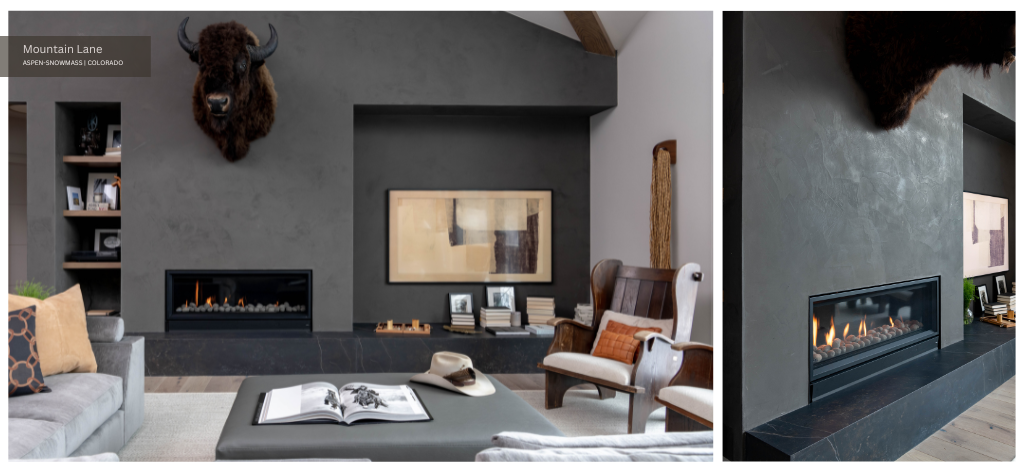
The hottest trends in fireplace design are diverse and cater to a range of aesthetic preferences. This year, the focus is on creating a unique and personalized look that complements the overall aesthetic of the living space. From traditional to ultra-modern, the design trends are catering to various tastes and interior themes.
In terms of materials, stone, metal, and tile continue to be popular choices for fireplace hearths and surrounds. Stone offers a timeless and natural look, metal provides a sleek and contemporary feel, while tile allows for creative and colorful designs. In terms of styles, there is a blend of minimalist approaches that emphasize clean lines and simplicity, alongside vintage designs that bring a touch of classic elegance. Colorful surrounds are also gaining popularity, adding a vibrant and unique character to the room.
These trends in fireplace surrounds are a reflection of current interior design preferences which favor both functionality and aesthetic appeal. The move towards personalized spaces is evident, with homeowners choosing designs that not only complement their existing decor but also express their individual style. The variety in materials and styles indicates a shift towards more versatile and adaptive design approaches in interior design.
Below are a few fireplace ideas to consider in your own home.
Sustainably-Made Fireplaces
There’s a growing trend towards eco-friendly fireplaces that blend luxury with environmental responsibility. Such fireplaces are crafted with sustainability in mind, often using solar energy in the manufacturing process. This trend reflects a broader movement towards ecological mindfulness in home design.
Frameless Fireplaces
The popularity of frameless linear wood or gas fireplaces continues. These fireplaces are often complemented with marble, tile, or stone decorations and can be designed as single-sided or see-through tunnels. They integrate seamlessly into the living space without taking up too much room, offering a clean and contemporary look.
Colorful Surrounds
Adding a pop of color to fireplace surrounds is becoming increasingly popular. By embracing bold colors, designers are turning fireplaces into vibrant centerpieces that reflect personal expression and add a unique character to the room.
Antique and Vintage Fireplaces
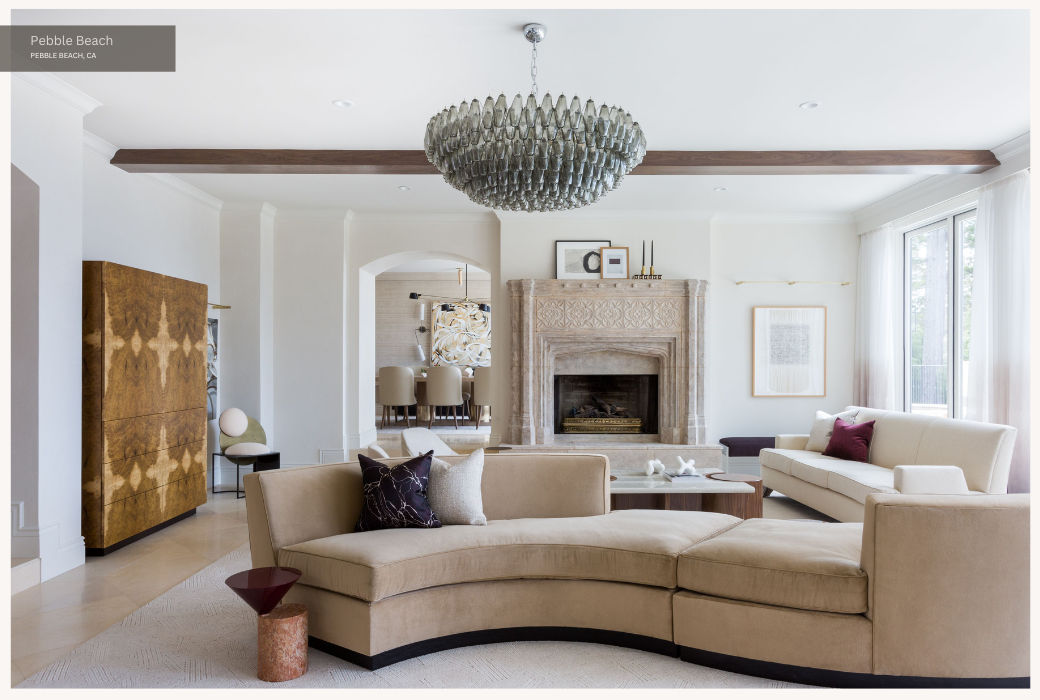
The charm of vintage fireplace designs is making a comeback. These designs feature intricate details, classic forms, and traditional materials like cast iron or patterned tiles. They add a layer of sophistication and warmth to spaces, often evoking a sense of history and craftsmanship. With intricate detailing, cast stone and carved wood fireplaces are especially popular in 2024.
Multifunctional Fireplace Designs
Multifunctional fireplaces are designed to maximize utility in modern living spaces. They serve dual purposes, such as being both a heat source and a media center or a room divider, making them a practical solution for smaller or open-plan living areas.
Metal Modern Fireplace Remodel Ideas
Steel or metal shiplap surrounds are gaining popularity for their sleek, contemporary look. These materials offer a minimalist and industrial feel, adding a bold statement to any space.
Full-Height Modern Fireplace Remodel Ideas
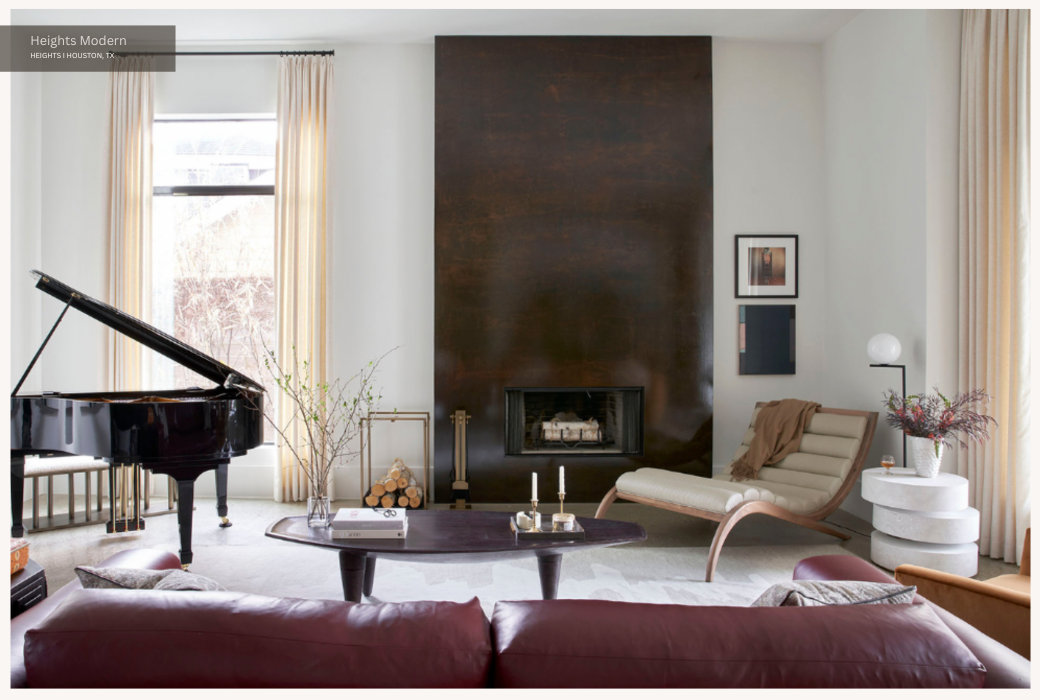
Full-height, linear fireplaces that extend to the ceiling are becoming a captivating architectural feature. They can make spaces feel more expansive and serve as a striking focal point.
Energy-Efficient Fireplace Upgrades
Many homeowners are looking to increase their fireplace’s energy efficiency. Upgrades like fireplace inserts improve heat efficiency and can also involve changing fuel sources for better sustainability.
Rustic and Natural Wood Mantel Shelves
This trend combines modern farmhouse and cottage styles, featuring wooden beam-like mantels that add a unique, rustic charm to the fireplace. Emphasizing a connection with nature, these mantels fit well with Scandinavian or minimalist decor, aligning with sustainable and eco-conscious design principles.
Fluted Mantels
Fluting, a design element characterized by grooves or ridges, is gaining popularity. This trend is often seen on the legs of full mantel surrounds, adding a classic and elegant texture. Incorporating the fluted mantel trend in your home will help your fireplace stand out.
Luxurious Stone Mantels and Surrounds
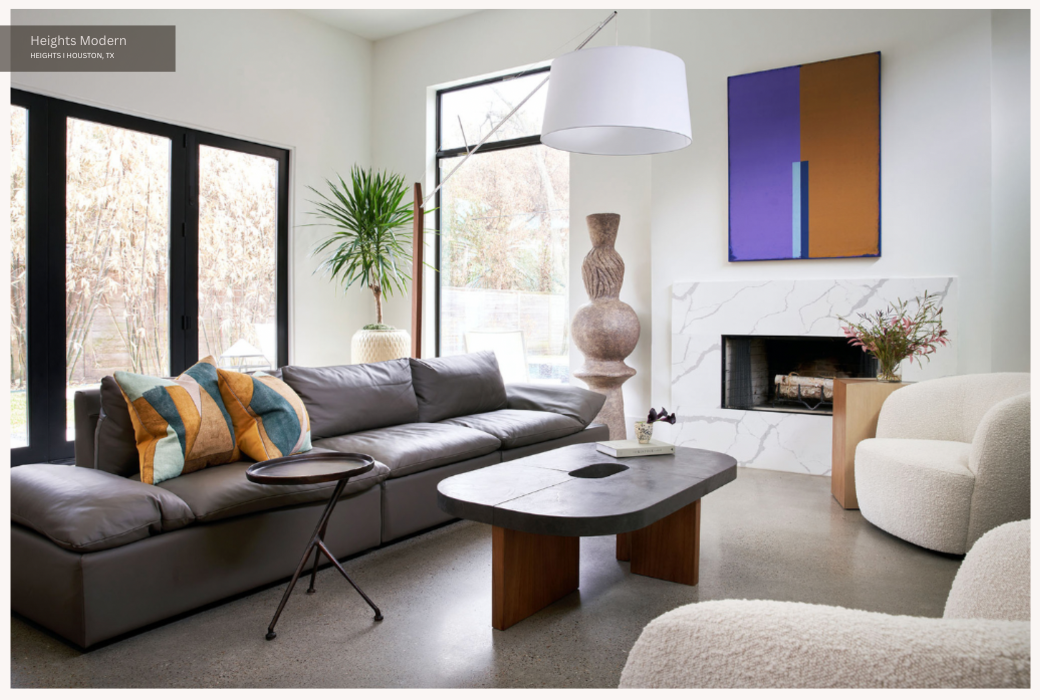
A natural stone surround is timeless for either an indoor or outdoor fireplace. Materials like ledgestone, fieldstone, and manufactured stone are popular for their aesthetic appeal and compatibility with various interior styles. Marble mantels are another excellent choice for those seeking a lasting statement. They range from designs reminiscent of French chateaus to more contemporary styles, adding a regal touch to any space.
Fireplaces as Focal Points of Indoor and Outdoor Living Spaces
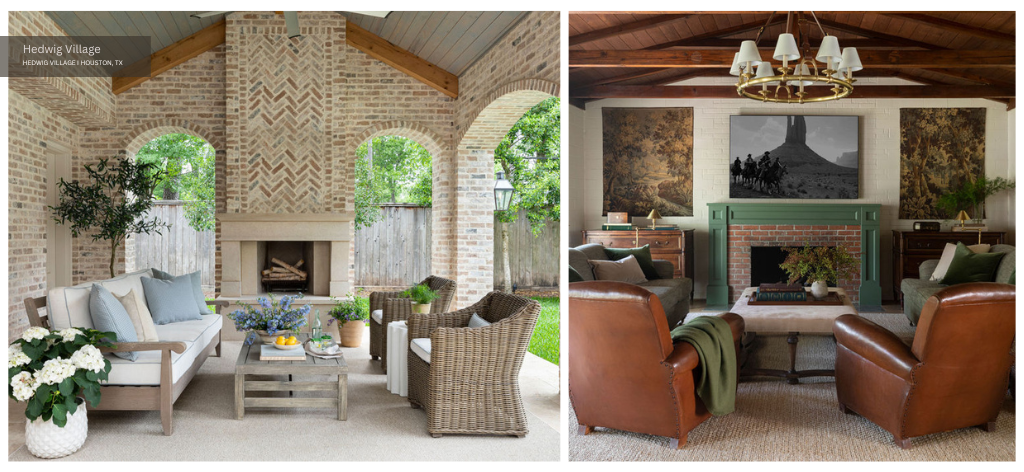
Many homeowners are swapping their budget-friendly fire pit for a cozy fireplace in a more formalized outdoor dining room or lounge area. This shift reflects a growing desire to extend comfortable living areas beyond the confines of indoor spaces, especially in year-round outdoor entertaining climates like we have here in Houston.
Outdoor fireplaces, ranging from traditional wood-burning to modern gas and electric models, are often incorporated into elaborate outdoor setups, including patios, decks, and gardens. They are designed to complement the aesthetic of the house while also blending seamlessly with the natural surroundings. This integration of fireplaces into outdoor living spaces encourages a more communal and engaging environment, promoting gatherings and leisure activities.
It highlights a broader trend towards creating more versatile, inviting, and usable outdoor spaces, where the fireplace acts as a natural gathering spot, providing warmth, ambiance, and a touch of sophistication. Pictured above is the outdoor fireplace built into the loggia of our Hedwig Village project.
Selecting the Ideal Fireplace for Your Home

Homeowners interested in updating the fireplaces in their living rooms, dining rooms, or primary bedrooms must consider a number of key factors. First, aligning the type of fireplace with your home design and lifestyle is crucial for both functionality and visual harmony. For a traditional or rustic home, a wood-burning fireplace might fit beautifully, adding to the classic charm of the space.
In contrast, modern or minimalist homes might benefit from the sleek and clean design of an electric fireplace. If convenience and ease of use are top priorities, especially in busy households, a gas fireplace could be the ideal choice. It’s also worth considering how the fireplace will be used – whether it’s for daily heating, occasional ambiance, or as a focal point for social gatherings.
For environmentally conscious homeowners, the choice of fireplace can significantly impact your home’s carbon footprint. Wood-burning fireplaces, while traditional, can emit more pollutants and require sourcing wood, which might not align with some green living principles. Gas fireplaces burn cleaner but still rely on fossil fuels. Electric fireplaces are the most eco-friendly, as they produce no emissions, and their impact can be further reduced if powered by renewable energy sources. Additionally, the efficiency of the fireplace in terms of heat output and energy consumption should align with your heating needs and energy-saving goals.
In selecting the right fireplace for your home, considering aesthetics, functionality, and overall design cohesion is crucial. To achieve seamless integration of your fireplace with your home’s style and decor, we recommend working closely with an interior design firm. Collaborating with a firm like Laura U Design Collective ensures that every aspect, from the type of fireplace to its placement and design, aligns with your home’s architecture and your personal style, creating a harmonious and inviting atmosphere.


